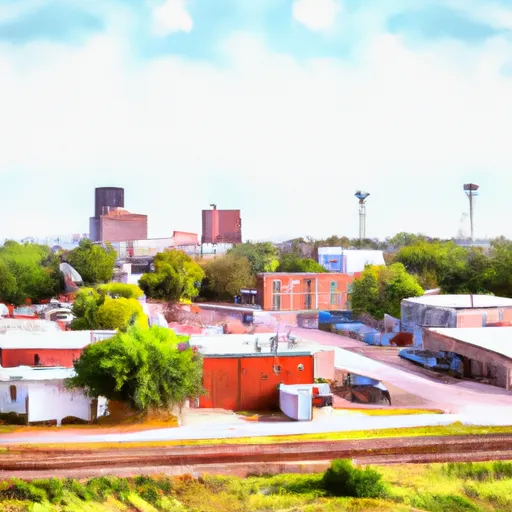-
 Snoflo Premium
Snoflo Premium
Get unlimited access to all our content
With no Ad interruptions! - Start Your Free Trial Login with existing account
Randolph
Eden Index
Climate
9.8
•
Recreation
2.5
•
Community
•
Safeguard
4.8/10

Randolph, Texas is a charming community located in the central part of the state. The town experiences a humid subtropical climate, characterized by hot, humid summers and mild winters. Summers in Randolph are generally hot, with temperatures often exceeding 90°F (32°C), and occasional thunderstorms providing relief from the heat. Winters are mild, with average temperatures hovering around 60°F (15°C).
The hydrology constituents in Randolph are abundant, with several creeks and small rivers flowing through the area. The region is known for its rich biodiversity and provides ample opportunities for outdoor recreation. Fishing enthusiasts can enjoy casting their lines in the numerous waterways, which are home to various fish species. Nature lovers can explore the lush green landscapes, with hiking trails offering breathtaking views of the surrounding countryside.
For those seeking more adventurous activities, Randolph is also close to lakes and reservoirs, providing opportunities for boating, water skiing, and swimming. The town's proximity to state parks and wildlife management areas ensures that outdoor recreation enthusiasts have plenty of options to explore and enjoy the natural beauty of Randolph, Texas.
What is the Eden Index?
The Snoflo Eden Index serves as a comprehensive rating system for regions, evaluating their desirability through a holistic assessment of climate health, outdoor recreation opportunities, and natural disaster risk, acknowledging the profound impact of these factors on livability and well-being.
Climate Health Indicator (CHI): 9.8
Randolph receives approximately
1095mm of rain per year,
with humidity levels near 75%
and air temperatures averaging around
18°C.
Randolph has a plant hardyness factor of
8, meaning
plants and agriculture in this region tend to thrive here all year round.
By considering the ideal temperature range, reliable water supplies, clean air, and stable seasonal rain or snowpacks, the Climate Health Indicator (CHI) underscores the significance of a healthy climate as the foundation for quality living.
A healthy climate is paramount for ensuring a high quality of life and livability in a region, fostering both physical well-being and environmental harmony. This can be characterized by ideal temperatures, reliable access to water supplies, clean air, and consistent seasonal rain or snowpacks.
Weather Forecast
Streamflow Conditions
Red-Little
Area Rivers
Red-Little
Snowpack Depths
Red-Little
Reservoir Storage Capacity
Red-Little
Groundwater Levels
Recreational Opportunity Index (ROI): 2.5
The Recreational Opportunity Index (ROI) recognizes the value of outdoor recreational options, such as parks, hiking trails, camping sites, and fishing spots, while acknowledging that climate plays a pivotal role in ensuring the comfort and consistency of these experiences.
Access to outdoor recreational opportunities, encompassing activities such as parks, hiking, camping, and fishing, is crucial for overall well-being, and the climate plays a pivotal role in enabling and enhancing these experiences, ensuring that individuals can engage in nature-based activities comfortably and consistently.
Camping Areas
| Campground | Campsites | Reservations | Toilets | Showers | Elevation |
|---|---|---|---|---|---|
| Holdenville Lake | None | 810 ft | |||
| Boggy Depot Park | None | 594 ft | |||
| Bonham State Park | 21 | 613 ft | |||
| Fairfield Lake State Park | 135 | 382 ft |
Nearby Fishing
Catastrophe Safeguard Index (CSI):
The Catastrophe Safeguard Index (CSI) recognizes that natural disaster risk, encompassing floods, fires, hurricanes, and tornadoes, can drastically affect safety and the overall appeal of an area.
The level of natural disaster risk in a region significantly affects safety and the overall livability, with climate change amplifying these risks by potentially increasing the frequency and intensity of events like floods, fires, hurricanes, and tornadoes, thereby posing substantial challenges to community resilience and well-being.
Community Resilience Indicator (CRI):
The Community Resilience Indicator (CRI) recognizes that education, healthcare, and socioeconomics are crucial to the well-being of a region. The CRI acknowledges the profound impact of these elements on residents' overall quality of life. By evaluating educational resources, healthcare accessibility, and economic inclusivity, the index captures the essential aspects that contribute to a thriving community, fostering resident satisfaction, equity, and social cohesion.

